ζ Pup: XMM RGS line-profile analysis
O VIII at 18.969 A
For this line we use both the RGS1 and RGS2 data, and as with the other lines, we do not allow shift to be a free parameter.
First we repeat the non-porous fit shown on the main page.
Non-porous: RGS1+2
RGS1

RGS2
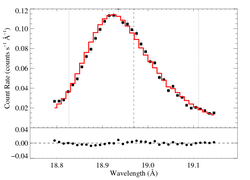
|
[18.78:19.15]
vinf = 2250
β = 1
powerlaw continuum, n = 2
norm = 9.77e-4 +/- (:)
q = 0
hinf = 0
taustar = 3.14 +/- (:)
Ro = 1.01 +/- (:)
shift = 0
norm = 4.66e-4 +/- (:)
chisq = 204.34 for N = 72
|
This fit is quite poor, again, with systematic errors likely dominating. And it looks like there are systematic shifts between the two datasets. We explored this in the previous set of fits. Summarizing those experiments, fitting only the RGS2 data yields a formally acceptable fit, with a somewhat lower taustar.
You can compare these results to the same sort of model fit to the Chandra spectrum. The results are similar.
Next, we'll fit models with anisotropic porosity assuming flattened, radially oriented clumps. We use the "stretch" porosity length distribution, h(r), parameterized by hinf. We will fit first with hinf a free parameter, and then at fixed values of hinf = 0.5, 1, 2, and 5 R*.
We cannot calculate formal confidence limits on the model parameters because the best-fit is not acceptably good.
aniso-porous: RGS1+2, hinf free
We find a best-fit hinf = 0 and so recover the non-porous fit. So we don't bother showing it here.
aniso-porous: RGS1+2, hinf = 0.5
RGS1
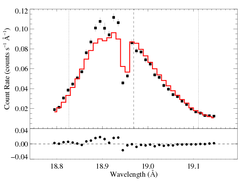
RGS2
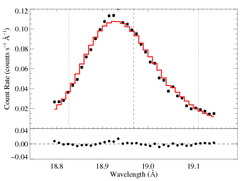
|
[18.78:19.15]
vinf = 2250
β = 1
powerlaw continuum, n = 2
norm = 6.32e-4 +/- (:)
q = 0
hinf = 0.5
taustar = 5.30 +/- (:)
Ro = 1.35 +/- (:)
shift = 0
norm = 4.76e-4 +/- (:)
chisq = 275.16 for N = 72
|
aniso-porous: RGS1+2, hinf = 1
RGS1

RGS2
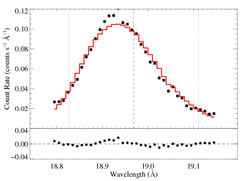
|
[18.78:19.15]
vinf = 2250
β = 1
powerlaw continuum, n = 2
norm = 4.59e-4 +/- (:)
q = 0
hinf = 1
taustar = 8.14 +/- (:)
Ro = 1.42 +/- (:)
shift = 0
norm = 4.81e-4 +/- (:)
chisq = 355.14 for N = 72
|
aniso-porous: RGS1+2, hinf = 2
RGS1

RGS2
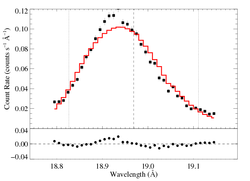
|
[18.78:19.15]
vinf = 2250
β = 1
powerlaw continuum, n = 2
norm = 2.27e-4 +/- (:)
q = 0
hinf = 2
taustar = 16.81 +/- (:)
Ro = 1.46 +/- (:)
shift = 0
norm = 4.87e-4 +/- (:)
chisq = 478.79 for N = 72
|
aniso-porous: RGS1+2, hinf = 5
RGS1
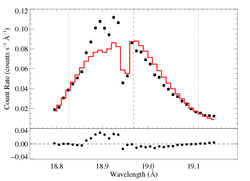
RGS2
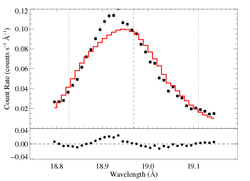
|
[18.78:19.15]
vinf = 2250
β = 1
powerlaw continuum, n = 2
norm = 2.e-11 +/- (:)
q = 0
hinf = 5
taustar = 73.81 +/- (:)
Ro = 1.37 +/- (:)
shift = 0
norm = 4.92e-4 +/- (:)
chisq = 645.79 for N = 72
|
Now for models with isotropic porosity.
iso-porous: RGS1+2, hinf free
RGS1

RGS2

|
[18.78:19.15]
vinf = 2250
β = 1
powerlaw continuum, n = 2
norm = 1.06e-3 +/- (:)
q = 0
hinf = 2.12 +/- (:)
taustar = 6.70 +/- (:)
Ro = 1.57 +/- (:)
shift = 0
norm = 4.63e-4 +/- (:)
chisq = 188.84 for N = 72
|
iso-porous: RGS1+2, hinf = 0.5
RGS1

RGS2
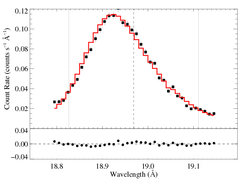
|
[18.78:19.15]
vinf = 2250
β = 1
powerlaw continuum, n = 2
norm = 1.03e-3 +/- (:)
q = 0
hinf = 0.5
taustar = 3.64 +/- (:)
Ro = 1.57 +/- (:)
shift = 0
norm = 4.64e-4 +/- (:)
chisq = 198.02 for N = 72
|
iso-porous: RGS1+2, hinf = 1
RGS1

RGS2
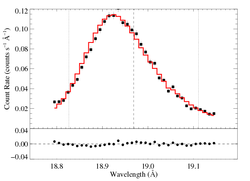
|
[18.78:19.15]
vinf = 2250
β = 1
powerlaw continuum, n = 2
norm = 1.06e-3 +/- (:)
q = 0
hinf = 1
taustar = 4.35 +/- (:)
Ro = 1.51 +/- (:)
shift = 0
norm = 4.64e-4 +/- (:)
chisq = 193.36 for N = 72
|
Note: with hinf = 1, taustar has increased by 39 percent.
iso-porous: RGS1+2, hinf = 2
RGS1

RGS2
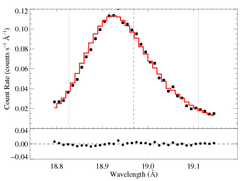
|
[18.78:19.15]
vinf = 2250
β = 1
powerlaw continuum, n = 2
norm = 1.07e-3 +/- (:)
q = 0
hinf = 2
taustar = 6.38 +/- (:)
Ro = 1.57 +/- (:)
shift = 0
norm = 4.63e-4 +/- (:)
chisq = 188.89 for N = 72
|
iso-porous: RGS1+2, hinf = 5
RGS1

RGS2
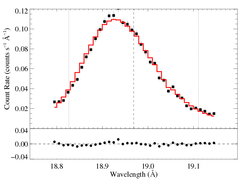
|
[18.78:19.15]
vinf = 2250
β = 1
powerlaw continuum, n = 2
norm = 9.20e-4 +/- (:)
q = 0
hinf = 5
taustar = 20.20 +/- (:)
Ro = 1.65 +/- (:)
shift = 0
norm = 4.67e-4 +/- (:)
chisq = 222.27 for N = 72
|
Back to the top
last modified: 16 May 2012



















